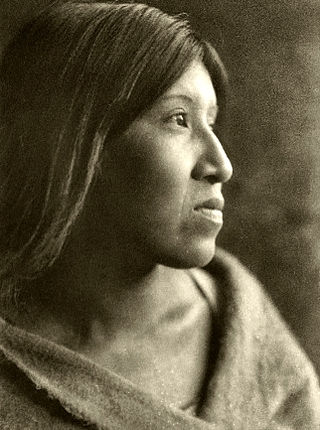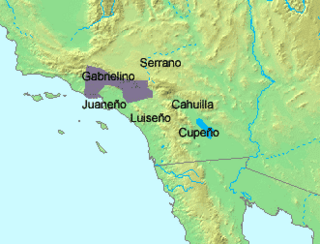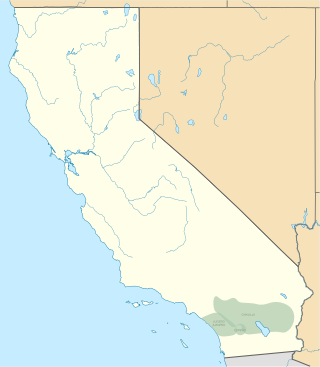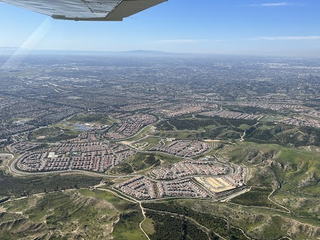
The Cahuilla, also known as ʔívil̃uqaletem or Ivilyuqaletem, are a Native American people of the various tribes of the Cahuilla Nation, living in the inland areas of southern California. Their original territory included an area of about 2,400 square miles (6,200 km2). The traditional Cahuilla territory was near the geographic center of Southern California. It was bounded to the north by the San Bernardino Mountains, to the south by Borrego Springs and the Chocolate Mountains, to the east by the Colorado Desert, and to the west by the San Jacinto Plain and the eastern slopes of the Palomar Mountains.

Uto-Aztecan, Uto-Aztekan is a family of indigenous languages of the Americas, consisting of over thirty languages. Uto-Aztecan languages are found almost entirely in the Western United States and Mexico. The name of the language family was created to show that it includes both the Ute language of Utah and the Nahuan languages of Mexico.

The Tongva language is an extinct Uto-Aztecan language formerly spoken by the Tongva, a Native American people who have lived in and around modern day Los Angeles for centuries. It has not been a language of everyday conversation since the 1940s. The Gabrielino people now speak English but a few are attempting to revive their language by using it in everyday conversation and ceremonial contexts. Presently, Gabrielino is also being used in language revitalization classes and in some public discussion regarding religious and environmental issues. Tongva is closely related to Serrano. The names of several cities and neighborhoods in Southern California are of Tongva origin, and include Pacoima, Tujunga, Topanga, Azusa, Cahuenga in Cahuenga Pass and Cucamonga in Rancho Cucamonga.

Serrano is a language in the Serran branch of the Uto-Aztecan family spoken by the Serrano people of Southern California. The language is closely related to Tongva, Tataviam, Kitanemuk and Vanyume. Serrano has free word order with the only rule being that verbs usually come last.
Kitanemuk was a Northern Uto-Aztecan language of the Serran branch. It was very closely related to Serrano, and may have been a dialect. It was spoken in the San Gabriel Mountains and foothill environs of Southern California. The last speakers lived some time in the 1940s, though the last fieldwork was carried out in 1937. J. P. Harrington took copious notes in 1916 and 1917, however, which has allowed for a fairly detailed knowledge of the language.
The Kitanemuk are an indigenous people of California. They traditionally lived in the Tehachapi Mountains and the Antelope Valley area of the western Mojave Desert of southern California, United States. Today some Kitanemuk people are enrolled in the federally recognized Tejon Indian Tribe of California.

The Serrano are an indigenous people of California. They use the autonyms of Taaqtam, meaning "people"; Maarrênga’yam, "people from Morongo"; and Yuhaaviatam, "people of the pines." Today the Maarrênga'yam are enrolled in the Morongo Band of Mission Indians, and the Yuhaviatam are enrolled in the San Manuel Band of Mission Indians. Additionally, some Serrano people are enrolled in the Soboba Band of Luiseno Indians.
The Tataviam language was spoken by the Tataviam people of the upper Santa Clara River basin, Santa Susana Mountains, and Sierra Pelona Mountains in southern California. It had become extinct by 1916 and is known only from a few early records, notably a few words recorded by Alfred L. Kroeber and John P. Harrington in the early decades of the 20th century. These word lists were not from native speakers, but from the children of the last speakers who remembered a few words and phrases.

The Tataviam are a Native American group in Southern California. The ancestral land of the Tataviam people includes northwest present-day Los Angeles County and southern Ventura County, primarily in the upper basin of the Santa Clara River, the Santa Susana Mountains, and the Sierra Pelona Mountains. They are distinct from the Kitanemuk and the Gabrielino-Tongva peoples.

The Nicoleño were an Uto-Aztecan people who lived on San Nicolas Island in California. Its population was "left devastated by a massacre in 1811 by sea otter hunters". Its last surviving member was given the name Juana Maria, who was born before 1811 and died in 1853.

Mission Indians are the indigenous peoples of California who lived in Southern California and were forcibly relocated from their traditional dwellings, villages, and homelands to live and work at 15 Franciscan missions in Southern California and the Asistencias and Estancias established between 1796 and 1823 in the Las Californias Province of the Viceroyalty of New Spain.

The Acjachemen are an Indigenous people of California. Published maps often identify their ancestral lands as extending from the beach to the mountains, south from what is now known as Aliso Creek in Orange County to the Las Pulgas Canyon in the northwestern part of San Diego County. However, sources also show that Acjachemen people shared sites with other indigenous nations as far north as Puvunga in contemporary Long Beach.

Cahuilla, or Ivilyuat, is an endangered Uto-Aztecan language, spoken by the various tribes of the Cahuilla Nation, living in the Coachella Valley, San Gorgonio Pass and San Jacinto Mountains region of southern California. The Cahuilla demonyms include Ɂívil̃uwenetem or Iviatam–speakers of Ivilyuat (Iviɂa)–or táxliswet meaning "person." A 1990 census revealed 35 speakers in an ethnic population of 800. With such a decline, Ivilyuat is classified as "critically endangered" by the UNESCO Atlas of the World's Languages in Danger as most speakers are middle-aged or older with limited transmission rates to children.

The Morongo Band of Mission Indians is a federally recognized tribe in California, United States. The main tribal groups are Cahuilla and Serrano. Tribal members also include Cupeño, Luiseño, and Chemehuevi Indians. Although many tribes in California are known as Mission Indians, some, such as those at Morongo, were never a part of the Spanish Missions in California.
Proto-Uto-Aztecan is the hypothetical common ancestor of the Uto-Aztecan languages. Authorities on the history of the language group have usually placed the Proto-Uto-Aztecan homeland in the border region between the United States and Mexico, namely the upland regions of Arizona and New Mexico and the adjacent areas of the Mexican states of Sonora and Chihuahua, roughly corresponding to the Sonoran Desert and the western part of the Chihuahuan Desert. It would have been spoken by Mesolithic foragers in Aridoamerica, about 5,000 years ago.

The Serran or Serrano-Gabrielino languages are a branch of the Uto-Aztecan language family that comprises the Serrano language, extinct Kitanemuk language, and Tongva, all indigenous to southern California. The branch has been considered to be part of the Takic subgroup, but there is doubt about the validity of Takic as a genetic unit, the similarities between the languages classed as Takic possibly being due primarily to borrowing.

The Cupan languages is a branch of the Uto-Aztecan language family that comprises Cupeño, Ivilyuat (Cahuilla), Luiseño-Juaneño, and perhaps Nicoleño, all historically spoken in southern California.
The Vanyume or Desert Serrano are an Indigenous people of Southern California. Traditional Vanyume territory extended along the Mojave River from the Eastern Mojave Desert to present day Victorville and may have included portions of southern Antelope Valley. The major village of Wá’peat was part of this area.

Orchard Hills is one of the master-planned communities of Irvine, California. To the east, it borders Limestone Canyon Regional Park, and to the west lies North Tustin, California. Located between 261 Highway and 241 Highway, the community is home to the Rattlesnake and Syphon reservoirs.














